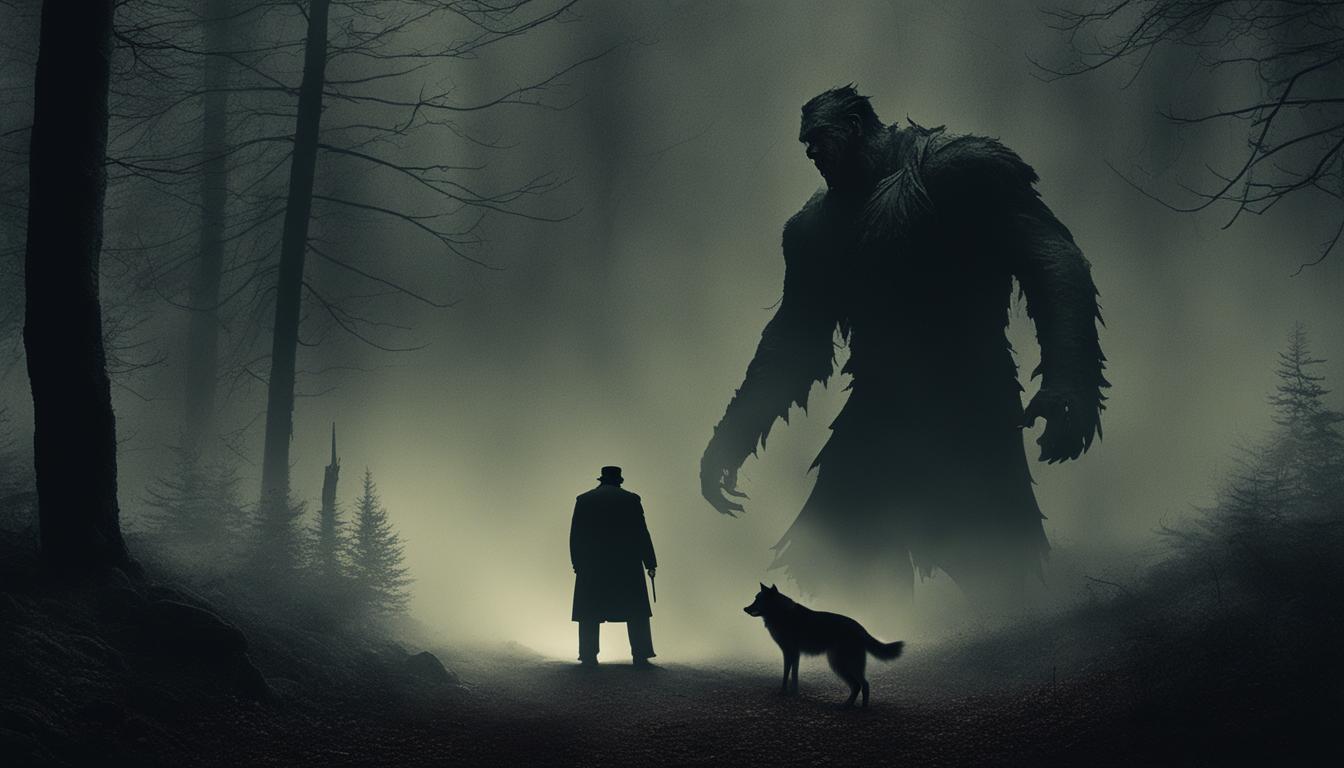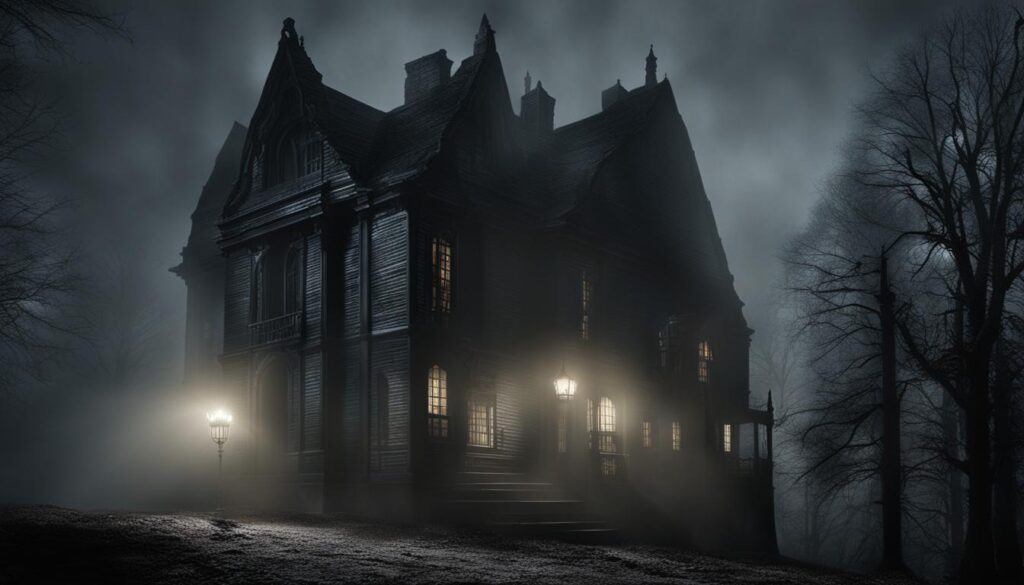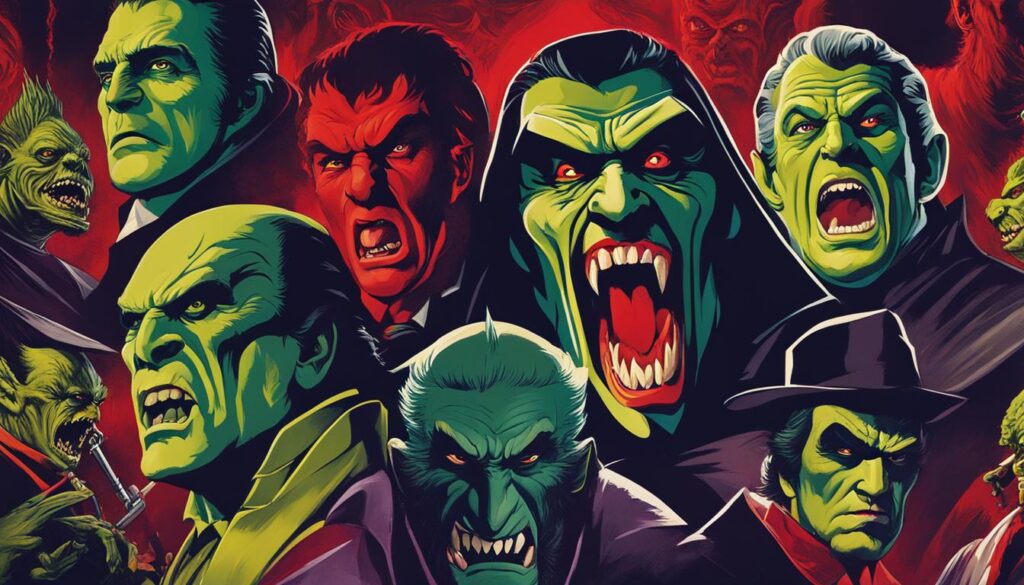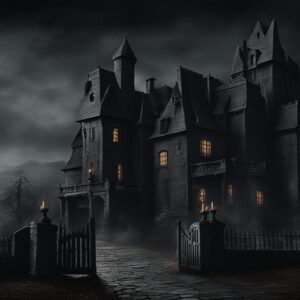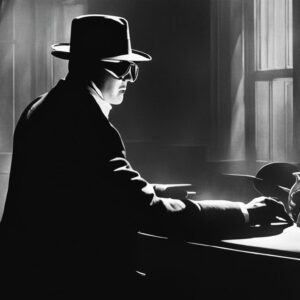Welcome to my review of the classic horror film, Frankenstein Meets the Wolf Man (1943). This film is a must-watch for fans of classic horror films and the Universal Monsters franchise. In this thrilling story, two iconic movie monsters, Frankenstein’s monster and the Wolf Man, come together for the first time, creating a milestone in the genre. Let’s dive into the details and uncover the charms of this unforgettable cinematic experience.
Key Takeaways:
- Frankenstein Meets the Wolf Man is a classic horror film that brings together two iconic movie monsters.
- The film established a shared universe of creatures, paving the way for future monster mashups.
- The portrayal of the Wolf Man by Lon Chaney Jr. remains compelling and showcases the character’s struggle with his curse.
- Although Bela Lugosi’s portrayal of Frankenstein’s Monster was heavily edited, it influenced the cultural perception of the character.
- Frankenstein Meets the Wolf Man is a testament to the enduring appeal of classic black and white films and the legacy of Universal Monsters.
The Plot and Characters
In “Frankenstein Meets the Wolf Man,” the plot focuses on the journey of Larry Talbot, played by Lon Chaney Jr., as he seeks a cure for his curse as the Wolf Man. Larry’s quest leads him to search for the renowned Dr. Frankenstein, hoping that the doctor’s knowledge can provide a remedy. However, he discovers that Dr. Frankenstein is deceased, and the townspeople despise his legacy.
During his search, Larry befriends Maleva, a wise gypsy woman who provides assistance. Together, they stumble upon the frozen remains of the infamous Frankenstein’s Monster. The film also introduces Elsa Frankenstein, Dr. Frankenstein’s daughter, who becomes an influential character in the story.
With its compelling plot and intriguing characters, “Frankenstein Meets the Wolf Man” takes audiences on a thrilling journey through the dark and interconnected world of these classic movie monsters.
The Characters
The main protagonist of the film is Larry Talbot, who struggles with his lycanthropy and seeks redemption. Lon Chaney Jr.’s portrayal of Talbot captures the anguish and desperation of a man trapped by his curse. Bela Lugosi also makes an appearance as the enigmatic Frankenstein’s Monster, although his performance was significantly edited, leading to a less impactful portrayal.
Maleva, the gypsy woman played by Maria Ouspenskaya, becomes Larry’s ally and guide throughout his quest. Her mystical knowledge and deep connection to the supernatural add depth and intrigue to the story. Additionally, the introduction of Elsa Frankenstein, played by Ilona Massey, brings a new perspective to the narrative as the daughter of the infamous Dr. Frankenstein.
| Character | Actor |
|---|---|
| Larry Talbot/Wolf Man | Lon Chaney Jr. |
| Frankenstein’s Monster | Bela Lugosi |
| Maleva | Maria Ouspenskaya |
| Elsa Frankenstein | Ilona Massey |
“Frankenstein Meets the Wolf Man” brings together two iconic movie monsters in a thrilling and suspenseful story. The complex characters, from the tormented Larry Talbot to the enigmatic Frankenstein’s Monster, add depth and intrigue to the plot. With their intertwined destinies, the film takes viewers on an exciting journey through the world of classic horror cinema.
The Portrayal of the Monsters
In Frankenstein Meets the Wolf Man, Bela Lugosi takes on the role of Frankenstein’s Monster, replacing Boris Karloff. However, Lugosi’s portrayal of the Monster is considered less effective due to his physical characteristics not aligning with the established look of the Monster. Additionally, much of Lugosi’s performance was cut from the film, leaving some scenes with the Monster appearing nonsensical. Despite this, Lon Chaney Jr.’s portrayal of the Wolf Man remains compelling, showcasing the character’s struggle with his curse and his quest for release.
“Lugosi’s portrayal of the Monster lacked the gravitas and presence that Karloff brought to the role. While Lugosi’s performance was edited down, Chaney Jr.’s Wolf Man stole the show with his tortured and sympathetic portrayal. The contrast between the two monsters is evident, with Chaney Jr. delivering a standout performance that continues to resonate with audiences today.”
The contrasting portrayals of the Monster and the Wolf Man in Frankenstein Meets the Wolf Man highlight the challenges of bringing iconic creatures to life onscreen. Lugosi’s performance may not have lived up to expectations, but it is still an interesting portrayal that contributes to the film’s legacy. Chaney Jr.’s compelling portrayal, on the other hand, solidifies his place as one of the most memorable actors to portray the Wolf Man.
Table: Comparison of Monster Portrayals
| Monster | Portrayal | Actor |
|---|---|---|
| Frankenstein’s Monster | Bela Lugosi’s portrayal | Bela Lugosi |
| Wolf Man | Lon Chaney Jr.’s portrayal | Lon Chaney Jr. |
Despite the mixed reception to Bela Lugosi’s portrayal and the standout performance of Lon Chaney Jr. as the Wolf Man, Frankenstein Meets the Wolf Man remains a classic horror film that brings together two iconic movie monsters in an unforgettable clash.
The Supporting Cast
Frankenstein Meets the Wolf Man boasts a talented supporting cast that brings depth and nuance to the film. Lionel Atwill delivers a commanding performance as the Mayor, exuding authority and adding to the overall atmosphere of the story. Patric Knowles plays the role of Larry Talbot’s doctor, providing a sense of scientific expertise and moral conflict. Maria Ouspenskaya shines as Maleva, the wise and mysterious gypsy woman who assists Larry Talbot in his quest for a cure. Finally, Ilona Massey portrays Elsa Frankenstein, adding a layer of complexity to the narrative as the daughter of the infamous Dr. Frankenstein.
Each actor in the supporting cast brings their unique talent and presence to the film, enhancing the overall storytelling and establishing a rich and immersive world within the movie. Their performances contribute to the atmospheric and suspenseful nature of the classic horror film, captivating audiences with their portrayals of memorable characters.
In particular, Ilona Massey’s character, Elsa Frankenstein, deserves special mention. Her role as the daughter of Dr. Frankenstein adds a dynamic element to the story, as she becomes entangled in the events surrounding the Wolf Man and the Monster. Massey’s portrayal of Elsa Frankenstein showcases her acting range and ability to convey a mix of vulnerability and strength.
The Supporting Cast:
| Actor | Character |
|---|---|
| Lionel Atwill | The Mayor |
| Patric Knowles | Larry Talbot’s Doctor |
| Maria Ouspenskaya | Maleva the Gypsy Woman |
| Ilona Massey | Elsa Frankenstein |
The supporting cast of Frankenstein Meets the Wolf Man showcases the talent and skill of these actors, elevating the film and adding depth to the overall narrative.
Monster Mashups and Cinematic Crossovers
Monster mashups have long been a staple in popular culture, captivating audiences with their unique blend of horror, suspense, and excitement. One notable example of this is the 1943 film “Frankenstein Meets the Wolf Man,” which brought together two iconic creatures from the Universal Monsters universe. This groundbreaking crossover event paved the way for future cinematic crossovers and shared universes.
With “Frankenstein Meets the Wolf Man,” audiences were treated to the thrilling clash between Frankenstein’s Monster and the Wolf Man, two legendary creatures with their own dedicated fan bases. This crossover not only showcased the power and appeal of these monsters but also set the stage for future mashup films, including the beloved “Abbott and Costello Meet Frankenstein.”
The success of “Frankenstein Meets the Wolf Man” and the subsequent monster mashup films that followed demonstrated the audience’s fascination with seeing their favorite creatures collide. Whether it’s witnessing the monstrous battle or exploring the complexities of these iconic characters, monster mashups provide a unique and exhilarating viewing experience.
| Monster Mashup Films | Release Year | Synopsis |
|---|---|---|
| “Frankenstein Meets the Wolf Man” | 1943 | Larry Talbot seeks a cure for his curse and encounters the frozen Frankenstein’s Monster. |
| “Abbott and Costello Meet Frankenstein” | 1948 | Comedy duo Abbott and Costello encounter Dracula, Frankenstein’s Monster, and the Wolf Man. |
| “King Kong vs. Godzilla” | 1962 | The iconic giant ape battles the legendary kaiju in an epic showdown. |
These films not only entertain but also tap into our fascination with the supernatural and the dark side of humanity. They provide a unique opportunity to see our favorite monsters interact in ways that both thrill and provoke thought. Monster mashups have become a beloved subgenre within the horror film community and continue to capture the imagination of audiences around the world.
The Impact of Monster Mashups on Pop Culture
The success of monster mashup films like “Frankenstein Meets the Wolf Man” extends beyond the silver screen, leaving a lasting impact on popular culture. These crossovers have inspired countless adaptations, spin-offs, and merchandise, further solidifying the iconic status of the Universal Monsters.
From action figures to comic books to video games, the legacy of these monster mashups lives on, captivating new generations of fans. The enduring popularity of these creatures is a testament to their timeless appeal and the enduring fascination with the supernatural and the macabre.
Monster mashups continue to be celebrated as a unique and thrilling subgenre within the horror film industry, showcasing the power of iconic creatures coming together in a shared universe. As new audiences discover these classic films, the popularity of monster mashups only grows, ensuring that the Universal Monsters and their crossover adventures will continue to be a cherished part of the horror genre for years to come.
The Climactic Monster Battle
One of the most thrilling moments in Frankenstein Meets the Wolf Man is the climactic battle between the two iconic monsters. As the tension builds throughout the film, audiences are eagerly anticipating their ultimate clash. The battle showcases the raw power and ferocity of both the Wolf Man and Frankenstein’s Monster, making it a highlight of the movie.
The scene begins with a dramatic confrontation as the Wolf Man, played by Lon Chaney Jr., confronts the resurrected Frankenstein’s Monster, portrayed by Bela Lugosi. The eerie atmosphere and dark setting create a sense of foreboding as the two creatures face off.
The battle itself is a mix of intense physicality and dramatic action sequences. The Wolf Man utilizes his agility and relentless attacks, while the Monster relies on his brute strength and towering presence. As they exchange blows, the lab equipment around them becomes collateral damage, intensifying the chaos.
| Monster | Attack | Strength |
|---|---|---|
| Wolf Man | Claw slashes | Agility |
| Frankenstein’s Monster | Powerful punches | Brute force |
As the battle reaches its climax, the tension peaks. The explosive dam explosion adds an element of danger and heightens the stakes for both creatures. This epic showdown between the Wolf Man and Frankenstein’s Monster leaves audiences on the edge of their seats, wondering how it will all end.
Although the climactic monster battle in Frankenstein Meets the Wolf Man may not have the same level of spectacle as modern monster battles, it remains a standout moment in the film. The combination of intense physicality, the destruction of the lab, and the explosive dam explosion create a visually engaging and thrilling experience for viewers.
Overall, the climactic monster battle in Frankenstein Meets the Wolf Man delivers on the promise of a thrilling clash between two iconic horror creatures. It encapsulates the excitement and suspense that audiences crave when watching monster mashup films. Whether you’re a fan of classic horror or simply enjoy the thrill of seeing these larger-than-life creatures collide, this scene is sure to leave a lasting impression.
The Influence of Bela Lugosi’s Frankenstein’s Monster
When discussing the cultural impact of Frankenstein Meets the Wolf Man, one cannot overlook the portrayal of Frankenstein’s Monster by Bela Lugosi. Despite the criticism and the deviation from the established look of the Monster, Lugosi’s interpretation has left a lasting impact on the cultural perception of Frankenstein. His distinctive portrayal, with arms outstretched and a hesitant, jerky walk, has become the accepted image of the Monster in popular culture.
Although Lugosi’s physical characteristics did not align with the traditional appearance of the Monster, his performance resonated with audiences and influenced later actors who portrayed the creature. One such example is Glenn Strange, who took on the role of the Monster in subsequent films, drawing inspiration from Lugosi’s interpretation. The lasting influence of Lugosi’s portrayal speaks to the power of his performance and the cultural significance of the characters in the Universal Monsters universe.
I have always been fascinated by Bela Lugosi’s portrayal of Frankenstein’s Monster in Frankenstein Meets the Wolf Man. Despite the criticisms, his unique mannerisms and physicality brought a certain vulnerability to the character. Lugosi’s performance may not have been entirely accurate, but it left an indelible mark on the cultural perception of the Monster.
Frankenstein Meets the Wolf Man is a testament to the enduring power of classic horror films and their ability to shape our collective imagination. Bela Lugosi’s portrayal of Frankenstein’s Monster in this film has become an iconic representation, leaving a cultural impact that continues to resonate with audiences today.
| Aspect | Lugosi’s Monster | Legacy |
|---|---|---|
| Physical Appearance | Deviation from established look | Established cultural image of the Monster |
| Performance | Unique mannerisms and physicality | Inspired later actors portraying the Monster |
| Cultural Perception | Impactful portrayal despite criticisms | Influenced the lasting image of the Monster |
The Legacy of Frankenstein Meets the Wolf Man
Frankenstein Meets the Wolf Man holds a significant place in the legacy of classic horror films. Released in 1943, this film represents the early era of old Hollywood horror and showcases the creativity of filmmakers during that time. It is a prime example of the iconic monster mashup films that have captivated audiences for decades.
Despite being over 75 years old, Frankenstein Meets the Wolf Man continues to resonate with viewers today. Its blend of horror, suspense, and character-driven storytelling creates an enduring appeal that transcends time. The film’s atmospheric black and white cinematography adds to its charm, evoking a sense of nostalgia for fans of classic horror.
Furthermore, Frankenstein Meets the Wolf Man set the stage for future monster mashups and shared universes in popular culture. It was the first time that the Universal Monsters were brought together in a single film, establishing an interconnected cinematic world. This concept would later be explored by other franchises and studios, leading to the rise of shared universes in modern cinema.
Overall, Frankenstein Meets the Wolf Man is a testament to the lasting impact of classic horror films from the 1940s. Its captivating storytelling, iconic characters, and pioneering approach to monster mashups have cemented its place in cinema history and continue to captivate audiences today.
The Influence of Classic Horror Films
Classic horror films from the 1940s, like Frankenstein Meets the Wolf Man, have had a profound influence on the horror genre. These movies laid the foundation for the tropes and conventions that still resonate with audiences today. They established the archetypal characters, atmospheric settings, and suspenseful narratives that have become hallmarks of the genre.
Moreover, classic horror films have inspired countless filmmakers, writers, and artists, shaping the way we perceive and appreciate the horror genre. Their enduring popularity is a testament to their storytelling prowess and cultural significance. Even in the modern age of CGI and special effects, the timeless appeal of classic horror films continues to captivate audiences and inspire new generations of filmmakers.
The Early Days of the Shared Universe
When it comes to shared universes in popular culture, Universal Pictures is often credited with pioneering the concept. The early days of the shared universe can be traced back to one of their iconic films, Frankenstein Meets the Wolf Man (1943). While the film may not have the seamless continuity of modern shared universes, it was groundbreaking in bringing together multiple characters from the Universal Monsters franchise in a single movie.
This early attempt at a shared universe was a significant step forward in popular culture, as it established an interconnected cinematic world where different characters could coexist and interact. While it may not have been fully realized in Frankenstein Meets the Wolf Man, this concept laid the foundation for future shared universes to explore, leading to the rise of the interconnected film franchises that we see today.
“The early days of the shared universe can be traced back to one of their iconic films, Frankenstein Meets the Wolf Man (1943).”
Universal Pictures’ ambitious approach to the shared universe concept in the 1940s opened up new possibilities for storytelling and expanded the horizons of popular culture. It inspired other studios and franchises to explore the idea of interconnected narratives, ultimately shaping the way we consume and engage with films. The early days of the shared universe in popular culture can be seen as a testament to Universal Pictures’ pioneering spirit and their commitment to pushing boundaries in storytelling.
As the concept of the shared universe continues to evolve and expand in modern cinema, it’s important to recognize the early days and the impact they had on shaping popular culture. Universal Pictures’ efforts with films like Frankenstein Meets the Wolf Man paved the way for the interconnected narratives we see today and contributed to the enduring legacy of the Universal Monsters franchise.
The Early Days of the Shared Universe
| Year | Film | Characters |
|---|---|---|
| 1943 | Frankenstein Meets the Wolf Man | Frankenstein’s Monster, Wolf Man |
| 1944 | House of Frankenstein | Frankenstein’s Monster, Wolf Man, Dracula |
| 1945 | House of Dracula | Frankenstein’s Monster, Wolf Man, Dracula |
The Charm of Classic Black and White Films
Classic black and white films hold a special charm that continues to captivate audiences, even in the era of modern technology and vibrant colors. These timeless movies, like Frankenstein Meets the Wolf Man, transport us to a bygone era of cinema, where storytelling and visual artistry took center stage. The use of black and white cinematography adds a certain allure to these films, creating a sense of nostalgia and a unique atmosphere that cannot be replicated.
The absence of color allows the audience to focus on the intricate details of the film, from the carefully crafted sets to the expressive performances of the actors. The interplay of light and shadow, the stark contrast, and the monochromatic palette add depth and texture to every scene, enhancing the overall visual impact. It is through these visual elements that classic black and white films create a sense of timelessness and evoke a certain mood that resonates with viewers.
Furthermore, black and white films have a way of highlighting the emotional nuances of a story, allowing the audience to fully immerse themselves in the narrative. With color stripped away, the focus shifts to the characters and their interactions, drawing attention to their expressions, body language, and dialogue. This emphasis on character development and storytelling creates a deeper connection between the audience and the film, enabling us to become fully engrossed in the cinematic experience.
Classic black and white films have stood the test of time, captivating audiences through their artistry and storytelling prowess. They offer a glimpse into the golden age of cinema, where black and white cinematography was an integral part of the storytelling process. These films continue to inspire and influence filmmakers, serving as a reminder of the enduring power of visual storytelling in its purest form.
The Thrill and Suspense of a Monster Mash
When it comes to the world of horror cinema, few things can match the excitement and anticipation of a monster mashup. The clash of iconic movie monsters in a single film creates a thrilling experience that keeps audiences on the edge of their seats. Frankenstein Meets the Wolf Man (1943) is a prime example of such a cinematic crossover, showcasing the raw power and magnetism of these larger-than-life creatures.
The combination of Frankenstein’s monster and the Wolf Man in one film creates a sense of novelty and excitement. Audiences are drawn into the clash between these supernatural beings, eagerly awaiting the climactic battle that unfolds before their eyes. The film expertly builds tension and suspense, heightening the thrill of the monster mashup.
Throughout Frankenstein Meets the Wolf Man, the atmosphere is palpable, with each scene rife with anticipation. The looming presence of the monsters, their struggles and motivations, adds layers of suspense to the narrative. As viewers, we are taken on a rollercoaster ride of emotions, from fear to awe, as we witness the clash of these iconic creatures.
| Film | Key Monsters | Thrill Level | Suspense Level |
|---|---|---|---|
| Frankenstein Meets the Wolf Man (1943) | Frankenstein’s monster, Wolf Man | High | High |
| Godzilla vs. Kong (2021) | Godzilla, Kong | Very high | Very high |
| Freddy vs. Jason (2003) | Freddy Krueger, Jason Voorhees | Extreme | Extreme |
Table: A comparison of thrilling and suspenseful monster mashup films
Overall, monster mashup films like Frankenstein Meets the Wolf Man deliver an exhilarating experience for viewers. The clash of iconic creatures, coupled with a masterful build-up of tension and suspense, creates a cinematic thrill that is hard to match. These films tap into our fascination with the supernatural and our desire for heart-pounding excitement, making them a staple in the world of suspenseful cinema.
The Importance of Universal Monsters
Universal Monsters have played a pivotal role in shaping the horror film genre and leaving a lasting legacy in popular culture. These iconic creatures, including Frankenstein’s monster, the Wolf Man, Dracula, and the Creature from the Black Lagoon, have become synonymous with classic horror and continue to captivate audiences to this day.
These Universal Monsters have had a significant impact on the horror film genre, inspiring countless adaptations, sequels, and reimaginings. Their enduring appeal lies in their ability to tap into universal fears and desires, exploring themes of identity, mortality, and the darker side of humanity. These creatures have become cultural icons, recognized worldwide and influencing the portrayal of monsters in literature, film, and other media.
The Universal Monsters franchise has also paved the way for the development of shared universes and cinematic crossovers. Films like Frankenstein Meets the Wolf Man brought these creatures together, establishing a connected universe of characters that would later be expanded upon. This concept of shared universes has become a popular trend in modern cinema, with other franchises and studios following suit.
Overall, the importance of Universal Monsters lies in their profound impact on the horror film genre and their status as cultural icons. Their enduring popularity and influence are a testament to the enduring power of classic horror and the timeless appeal of these iconic creatures.
Iconic Movie Monsters and Their Enduring Popularity
Frankenstein’s monster and the Wolf Man are two of the most iconic movie monsters in cinematic history. These creatures have captured the imagination of audiences for decades, becoming beloved symbols of the horror genre.
Frankenstein’s monster, with its towering stature and bolts through the neck, represents the dark side of science and the consequences of playing with life. It taps into our fascination with creation and the fear of the unknown. The Monster’s enduring popularity can be attributed to its striking visual design and the complex portrayal by actors such as Boris Karloff and Bela Lugosi. The Monster remains an iconic figure that continues to inspire fear and sympathy in equal measure.
The Wolf Man, on the other hand, embodies our primal fears and the struggle between man and beast. This creature represents the duality of human nature, exploring the inner conflict of our own animalistic instincts. Lon Chaney Jr.’s performance as the tortured Larry Talbot, cursed with lycanthropy, brought depth and humanity to the character. The Wolf Man’s enduring popularity can be credited to its relatability and the timeless themes it explores.
Both Frankenstein’s monster and the Wolf Man have transcended the horror genre, making appearances in various mediums and adaptations. They have become cultural icons, inspiring countless movies, books, and merchandise. Their enduring popularity can be attributed to their timeless appeal and the universal fears and desires they represent. These iconic creatures continue to captivate audiences of all ages, ensuring their place in the annals of cinematic history.
The Allure of Old Hollywood Horror
Old Hollywood horror films, such as Frankenstein Meets the Wolf Man, have a unique allure that captivates audiences to this day. These films represent a bygone era of filmmaking, where practical effects and atmospheric storytelling took center stage. The combination of suspense, mystery, and iconic monsters creates a sense of nostalgia and excitement for fans of classic horror. Old Hollywood horror films continue to be celebrated for their lasting impact on the genre.
These films transport viewers to a time when horror was crafted with creativity and ingenuity. The use of black and white cinematography adds a timeless quality to the movies, enhancing the atmospheric setting and creating a sense of nostalgia. The visual style and storytelling techniques of these films hold a certain charm and appeal that cannot be replicated in modern cinema. They remind us of the power of practical effects and the artistry of filmmaking.
Old Hollywood horror films are a testament to the enduring power of classic monster films. Despite their age, these movies continue to captivate and entertain audiences, showcasing the timeless appeal of the horror genre. Whether it’s the iconic creatures, the gripping storytelling, or the nostalgic atmosphere, old Hollywood horror films have left an indelible mark on the world of cinema. They are a reminder of the rich history and legacy of the genre, deserving of recognition and appreciation.
The Enduring Appeal of Monster Mashups
Monster mashups have long held a special place in the hearts of horror fans, offering a thrilling blend of classic creatures and pulse-pounding action. These crossovers, like Frankenstein Meets the Wolf Man, tap into our fascination with the supernatural and the dark side of humanity, creating an irresistible combination that continues to captivate audiences. The enduring appeal of monster mashups lies in their ability to bring together iconic movie monsters, allowing fans to witness epic battles and unexpected alliances.
One of the key reasons why monster mashups remain popular is the excitement of seeing beloved creatures collide. Whether it’s Frankenstein’s monster facing off against the Wolf Man or Dracula teaming up with the Mummy, these crossovers provide a unique opportunity to witness iconic characters sharing the screen. The clash of different personalities, powers, and motivations adds depth and complexity to the story, creating a sense of anticipation and intrigue.
Another factor that contributes to the enduring appeal of monster mashups is the opportunity for filmmakers to explore new narratives and expand on established mythology. By bringing together different creatures from established franchises, these films can delve into untapped storylines, uncover hidden depths of characters, and introduce exciting new dynamics. This allows for fresh interpretations and reimaginations of beloved monsters, breathing new life into their legacies and keeping audiences engaged.
The Enduring Appeal of Monster Mashups
Monster mashups are also a celebration of the rich history of classic horror cinema. By bringing together creatures from different eras and film series, these crossovers pay homage to the iconic characters and the filmmakers who brought them to life. They serve as a reminder of the enduring popularity of Universal Monsters and the lasting impact they have had on the horror genre.
| Advantages of Monster Mashups | Examples of Classic Horror Crossovers |
|---|---|
|
|
Monster mashups tap into our fascination with the supernatural and the dark side of humanity, creating an irresistible combination that continues to captivate audiences.
In conclusion, the enduring appeal of monster mashups lies in their ability to bring together iconic movie monsters, offering thrilling clashes and unexpected alliances. These crossovers provide excitement, fresh storytelling opportunities, and a celebration of classic horror cinema. From Frankenstein Meets the Wolf Man to Abbott and Costello Meet Frankenstein, these films offer a unique and exhilarating experience for fans of the genre. The fascination with monster mashups will continue to endure, as audiences eagerly await the next thrilling encounter between their favorite creatures.
Conclusion
In my analysis of Frankenstein Meets the Wolf Man (1943), I can confidently say that this classic horror film is a thrilling and suspenseful experience. Despite its flaws, it holds an important place in the legacy of old Hollywood horror and the Universal Monsters franchise.
The film’s portrayal of the Wolf Man, brilliantly portrayed by Lon Chaney Jr., captures the character’s struggle with his curse and his quest for release. Additionally, the introduction of Bela Lugosi as the Monster, although edited and less impactful, adds an interesting dynamic to the story.
Overall, Frankenstein Meets the Wolf Man is a must-watch for fans of classic horror films. Its timeless monster mash and the atmospheric setting offer a nostalgic and exciting experience. This film remains a testament to the creativity and enduring appeal of the Universal Monsters franchise.
FAQ
Is Frankenstein Meets the Wolf Man a classic horror film?
Yes, Frankenstein Meets the Wolf Man is considered a classic horror film.
What is the plot of Frankenstein Meets the Wolf Man?
The film follows Larry Talbot as he seeks a cure for his curse and teams up with Maleva, a gypsy woman, to find Dr. Frankenstein.
Who plays Frankenstein’s Monster in Frankenstein Meets the Wolf Man?
Bela Lugosi takes on the role of Frankenstein’s Monster in this film.
What is the significance of Frankenstein Meets the Wolf Man in the Universal Monsters franchise?
The film is considered a milestone in the genre, as it was the first crossover event of the Universal Monsters, establishing a shared universe of creatures.
Who are some of the supporting cast members in Frankenstein Meets the Wolf Man?
The film features Lionel Atwill, Patric Knowles, Maria Ouspenskaya, and Ilona Massey in supporting roles.
Does Frankenstein Meets the Wolf Man have a climactic monster battle?
Yes, the film features a climactic battle between Frankenstein’s Monster and the Wolf Man.
How did Bela Lugosi’s portrayal of Frankenstein’s Monster impact the cultural perception of the character?
Despite its flaws, Lugosi’s version of the Monster has become the accepted cultural image of Frankenstein, influencing future portrayals of the character.
What is the legacy of Frankenstein Meets the Wolf Man in the horror film genre?
The film holds a significant place in the legacy of classic horror films and the Universal Monsters franchise, paving the way for future monster mashups and shared universes.
How did Frankenstein Meets the Wolf Man contribute to the rise of shared universes in popular culture?
The film was one of the first instances of bringing together multiple iconic creatures in a single film, establishing an interconnected cinematic world.
What is the appeal of classic black and white films like Frankenstein Meets the Wolf Man?
Black and white cinematography adds a timeless quality to the movie, creating a sense of nostalgia and enhancing the atmospheric setting.
Why do monster mashup films like Frankenstein Meets the Wolf Man thrill and captivate audiences?
The combination of different creatures in a single film creates a sense of novelty and excitement, allowing fans to see their favorite monsters collide.
What is the importance of the Universal Monsters franchise in the horror film genre?
The Universal Monsters have become synonymous with classic horror and have had a significant impact on the genre and pop culture as a whole.
What makes Frankenstein’s monster and the Wolf Man such iconic movie monsters?
Their striking visual designs, compelling characterizations, and ability to tap into universal fears and desires contribute to their enduring popularity.
Why do old Hollywood horror films like Frankenstein Meets the Wolf Man have such allure?
These films represent a bygone era of filmmaking, where practical effects and atmospheric storytelling were at the forefront, creating a sense of nostalgia and charm.
What is the enduring appeal of monster mashups like Frankenstein Meets the Wolf Man?
Monster mashups allow fans to see their favorite creatures interact and collide, creating memorable moments and tapping into our fascination with the supernatural and the dark side of humanity.

